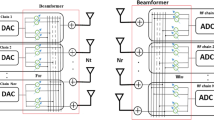Abstract
A M-MIMO is an optimistic method to magnify spectral efficiency (SE) of cell support system, by sending antenna patterns with many active components at base stations and performing logical transceiver developing. A standard concept of thumb is that information systems ought to be a commission of magnitude many antennas F, then regular users U, because the user’s channels are belike to be nearly perpendicular when F = U > 10. But, it doesn’t demonstrate this concept of thumb really increases the SE. In the study of this research paper, we look at how much the optimal range of daily users, U Depending on the configuration of F and other information systems. End of latest SE expressions can be determined that enable efficient information system regularly investigation with power order, absolute pilot reuse and irregular user position. The precious value U in broad-F organization is derivative in not open form, while dissimulations are utilized to sign what go over at limited F, in various interference scenes, as well as various pilot reuse parameters and to various development strategy. Pilots can account for up to half of the continuity block and the ideal F = U is less than 10 at different points in time that are realistically relevant. Absorbingly Depends potent at processing interact and so it is below the belt to similitude various plot the same U.
Access this chapter
Tax calculation will be finalised at checkout
Purchases are for personal use only
Similar content being viewed by others
References
Foschini G, Gans M (1998) On limits of wireless communications in a fading environment when using multiple antennas. Wirel Pers Commun 6:311–335. https://doi.org/10.1023/A:1008889222784
Larsson EG, Edfors O, Tufvesson F, Marzetta TL (2014) Massive MIMO for next generation wireless systems. IEEE Commun Mag 52(2):186–195. https://doi.org/10.1109/MCOM.2014.6736761
Raleigh GG, Cioffi JM (1998) Spatio-temporal coding for wireless communication. IEEE Trans Commun 46(3):357–366. https://doi.org/10.1109/26.662641
Paulraj A, Kailath T (1994) Increasing capacity in wireless broadcast systems using distributed transmission/directional reception (DTDR). U.S. Patent 5 345 599, Sep 6, 1994
Gesbert D, Kountouris M, Heath Jr RW, Chae C, Chae T (2007) Shifting the MIMO paradigm. IEEE Sig Process Mag 24(5):36–46
Caire G, Shamai S (2003) On the achievable throughput of a multi antenna Gaussian broadcast channel. IEEE Trans Inf Theory 49:1691–1706. https://doi.org/10.1109/TIT.2003.813523
Viswanath P, Tse DNC (2003) Sum capacity of the vector Gaussian broadcast channel and uplink–downlink duality. IEEE Trans Inf Theory 49(8):1912–1921. https://doi.org/10.1109/TIT.2003.814483
Vishwanath S, Jindal N, Goldsmith A (2003) Duality, achievable rates, and sum-rate capacity of Gaussian MIMO broadcast channels. IEEE Trans Inf Theory 49(10):2658–2668. https://doi.org/10.1109/TIT.2003.817421
Marzetta TL (2006) How much training is required for multiuser Mimo? In: 2006 Fortieth asilomar conference on signals, systems and computers, pp 359–363. https://doi.org/10.1109/ACSSC.2006.354768
Rusek F et al (2013) Scaling up MIMO: opportunities and challenges with very large arrays. IEEE Signal Process Mag 30(1):40–60. https://doi.org/10.1109/MSP.2011.2178495
Telatar E (1999) Capacity of multi-antenna Gaussian channels. Eur Trans Telecomm 10:585–595. https://doi.org/10.1002/ett.4460100604
Marzetta TL (2010) Noncooperative cellular wireless with unlimited numbers of base station antennas. IEEE Trans Wirel Commun 9(1):3590–3600
Li Y, Nam Y-H, Ng BL, Zhang J (2012) A non-asymptotic throughput for massive MIMO cellular uplink with pilot reuse. In: IEEE global communications conference (GLOBECOM), 4500–4504. https://doi.org/10.1109/GLOCOM.2012.6503827
Müller RR, Cottatellucci L, Vehkaperä M (2014) Blind pilot decontamination. IEEE J Sel Top Signal Process 8(5):773–786. https://doi.org/10.1109/JSTSP.2014.2310053
Yin H, Gesbert D, Filippou M, Liu Y (2013) A coordinated approach to channel estimation in large-scale multiple-antenna systems. IEEE J Sel Areas Commun 31(2):264–273. https://doi.org/10.1109/JSAC.2013.130214
Li M, Jin S, Gao X (2013) Spatial orthogonality-based pilot reuse for multi-cell massive MIMO transmission. In: International conference on wireless communications and signal processing, 1–6. https://doi.org/10.1109/WCSP.2013.6677139
Karlsson M, Larsson EG (2014) On the operation of massive MIMO with and without transmitter CSI. In: 2014 IEEE 15th international workshop on signal processing advances in wireless communications (SPAWC), pp 1–5. https://doi.org/10.1109/SPAWC.2014.6941305
Gao X, Edfors O, Rusek F, Tufvesson F (2015) Massive MIMO performance evaluation based on measured propagation data. IEEE Trans Wirel Commun 14(7):3899–3911. https://doi.org/10.1109/TWC.2015.2414413
Guo K, Guo Y, Fodor G, Ascheid G (2014) Uplink power control with MMSE receiver in multi-cell MU-massive-MIMO systems. In: IEEE international conference on communications (ICC), 5184–5190. https://doi.org/10.1109/ICC.2014.6884144
Yang H, Marzetta TL (2014) A macro cellular wireless network with uniformly high user throughputs. In: 2014 IEEE 80th vehicular technology conference (VTC2014-Fall), pp 1–5. https://doi.org/10.1109/VTCFall.2014.6965818
Biguesh M, Gershman AB (2004) Downlink channel estimation in cellular systems with antenna arrays at base stations using channel probing with feedback. EURASIP J Adv Signal Process 963649. https://doi.org/10.1155/S1110865704403023
Acknowledgements
I would like to thank Mr. Kuldeep Singh, Mr. Anuj Singal and Mrs.Manisha Jangra from GJUS&T, Hisar (125001) for her generous help in improving this paper.
Author information
Authors and Affiliations
Editor information
Editors and Affiliations
Rights and permissions
Copyright information
© 2022 The Author(s), under exclusive license to Springer Nature Singapore Pte Ltd.
About this paper
Cite this paper
Mittal, S., Singal, A., Singh, K., Jangra, M. (2022). Spectral Efficiency Analysis of Massive MIMO. In: Gupta, D., Polkowski, Z., Khanna, A., Bhattacharyya, S., Castillo, O. (eds) Proceedings of Data Analytics and Management . Lecture Notes on Data Engineering and Communications Technologies, vol 91. Springer, Singapore. https://doi.org/10.1007/978-981-16-6285-0_6
Download citation
DOI: https://doi.org/10.1007/978-981-16-6285-0_6
Published:
Publisher Name: Springer, Singapore
Print ISBN: 978-981-16-6284-3
Online ISBN: 978-981-16-6285-0
eBook Packages: Intelligent Technologies and RoboticsIntelligent Technologies and Robotics (R0)




